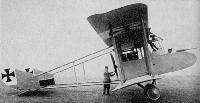
Описание
Страна: Германия
Год: 1916
Fighter
O.Thetford, P.Gray German Aircraft of the First World War (Putnam)
Euler C
Built to the pusher formula, the C was type tested during August 1916 and was armed with two Parabellum machine-guns. Only one machine was built. Engine, 160 h.p. Mercedes D III. Span, 14.8 m. (48 ft. 6 3/4 in.). Length, 9.3 m. (30 ft. 6 1/8 in.). Height, 3.2 m. (10 ft. 6 in.). Area, 52.6 sq.m. (568 sq.ft.). Weights: Empty, 492 kg. (1,082 lb.). Climb, 3.000 m. (9,840 ft.) in 44 min. Duration, 4 hr.
Euler
An experimental single-seat pusher design powered with 160 h.p. Mercedes D III engine. No details available.
Описание:
- O.Thetford, P.Gray German Aircraft of the First World War (Putnam)
- W.Green, G.Swanborough The Complete Book of Fighters
Фотографии
-
W.Green, G.Swanborough - The Complete Book of Fighters
The Euler "Gelber Hund" of 1915 which featured a fixed forward-firing machine gun in the extreme nose of the fuselage pod.
An experimental single-seat pusher design powered with 160 h.p. Mercedes D III engine. No details available.
Known as the "Gelber Hund", this single-seat pusher was the first Euler-Werke fighting scout. -
M.Dusing - German Aviation Industry in WWI. Volume 1 /Centennial Perspective/ (84)
Eul single-seat combat airplane (1915)
-
M.Dusing - German Aviation Industry in WWI. Volume 1 /Centennial Perspective/ (84)
Eul two-seater combat airplane (1915)
-
W.Green, G.Swanborough - The Complete Book of Fighters
The initial form with nose turret of the Euler two-seat fighter of 1915 intended primarily for anti-airship and escort missions.
-
W.Green, G.Swanborough - The Complete Book of Fighters
The final form of the Euler two-seat fighter of 1915 with faired, pulpit-like gun position, intended primarily for anti-airship and escort missions.
-
K.Delve - World War One in the Air /Crowood/
Euler C-type under test in mid 1916: note the armament of two parabellum machine guns. This, along with the Spandau, was a very effective aerial weapon and a success for German machine gun technology.







